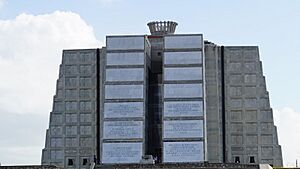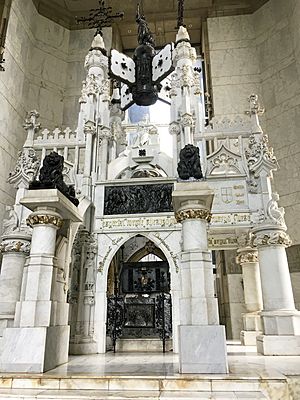Columbus Lighthouse facts for kids

The Columbus Lighthouse
|
|
| Lua error in Module:Location_map at line 420: attempt to index field 'wikibase' (a nil value). | |
| Established | 1992 |
|---|---|
| Location | Santo Domingo Este |
| Type | Mausoleum, Museum |
| Architect | Teófilo Carbonell J. L. Gleave |
The Columbus Lighthouse (also called Faro a Colón in Spanish) is a huge monument in the Dominican Republic. It's a special place dedicated to Christopher Columbus. This amazing structure is located in Santo Domingo Este.
Building this lighthouse started in 1986. It was designed by a Scottish architect named J.L. Gleave way back in 1931. The monument officially opened in 1992. This was just in time for the 500th anniversary of Columbus's first big trip across the ocean. Many countries in Latin America helped pay for it, costing about $70 million.
The monument looks like a lighthouse and shines bright beams of light. These lights form a giant cross in the sky. They are so powerful that you can even see them from nearby Puerto Rico!
About the Columbus Lighthouse
The Columbus Lighthouse is shaped like a cross. It's made of strong concrete and is about 680 feet (207 meters) long and 195 feet (59 meters) wide. The cross shape is meant to represent Christianity in the Americas.
From the monument, 157 beams of light shoot up into the sky. There's also a light that spins around. This spinning light is so bright it can even be seen from space!
Dominican officials say that the lighthouse holds the remains of Christopher Columbus. However, scientists in Spain have done DNA tests. These tests show that Columbus's remains are in the Cathedral of Seville. Some researchers think it's possible that some of his bones could be in both places.
The Dominican authorities have not allowed DNA tests on the remains in the lighthouse. This means we can't be completely sure if Columbus's remains are there.
The monument is both a mausoleum (a building that holds remains) and a museum. The museum has many interesting items. These include a boat from Cuba and beautiful jewelry from Colombia.
Once a year, on Columbus Day, the remains are shown to the public. They are kept safe behind a sheet of glass.
History of the Monument
The idea for a monument to Columbus in Santo Domingo came from a Dominican historian. His name was Antonio Delmonte y Tejada. He wrote about it in his book in 1852. Later, in 1914, an American named Pulliam William Ellis started telling newspapers about building a huge beacon. He wanted it in the first city of the New World.
The idea was accepted at a big meeting in Chile in 1923. It was decided that all American countries should work together to build this monument.
A Scottish architect, Joseph Lea Gleave, won a design competition in 1931. There were 455 people from 48 countries who entered! Famous architects like Eliel Saarinen and Frank Lloyd Wright were judges.
However, by 1950, only a few countries had given money. The Dominican government started digging the foundation in 1948. But then, political problems stopped the building work.
Construction didn't start again until 1986. This was during the time of President Joaquín Balaguer. A Dominican architect, Teófilo Carbonell, oversaw the work. The lighthouse was finally finished in 1992. This was just in time for the 500th anniversary of Columbus's arrival in the Americas.
Joseph Lea Gleave first designed the monument as a mausoleum. But President Balaguer wanted it to also be a museum. So, it was changed to hold exhibitions from countries in the Americas, Europe, and Asia. These exhibitions show important cultural items from each country.
More to Explore
- List of monuments and memorials to Christopher Columbus
See also
 In Spanish: Faro a Colón para niños
In Spanish: Faro a Colón para niños



